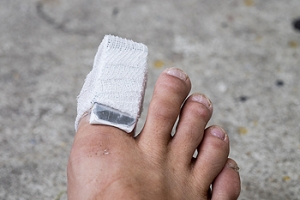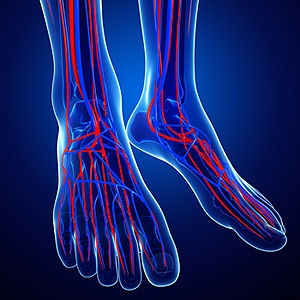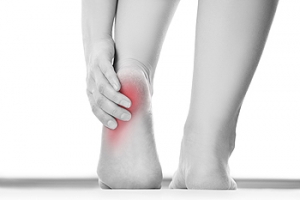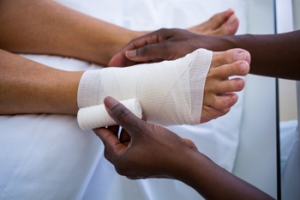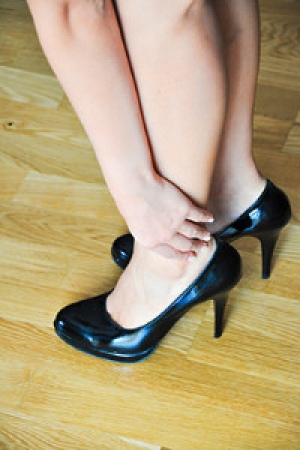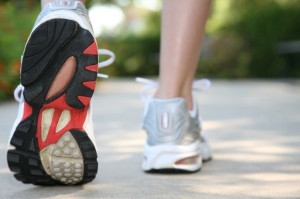Connect With Us
Featured Articles
Super User
Symptoms of a Broken Toe
 Severe pain is likely to be experienced if you have a broken toe, and it will typically heal within 6 weeks. The toe may be tender, bruised, and swollen, often resulting in difficulty in walking. The treatment for a broken or bruised toe is the same, despite the fact that many people have trouble differentiating between the two. Temporary relief may come from elevating the foot, which generally helps in reducing any pain or swelling associated with this condition. Additionally, choosing to wear shoes that give the toes ample room to move may aid in diminishing any discomfort that may be experienced. If the toe is bent at an unnatural angle indicating a severe break, a consultation with a podiatrist is suggested for ways to properly treat your broken toe.
Severe pain is likely to be experienced if you have a broken toe, and it will typically heal within 6 weeks. The toe may be tender, bruised, and swollen, often resulting in difficulty in walking. The treatment for a broken or bruised toe is the same, despite the fact that many people have trouble differentiating between the two. Temporary relief may come from elevating the foot, which generally helps in reducing any pain or swelling associated with this condition. Additionally, choosing to wear shoes that give the toes ample room to move may aid in diminishing any discomfort that may be experienced. If the toe is bent at an unnatural angle indicating a severe break, a consultation with a podiatrist is suggested for ways to properly treat your broken toe.
A broken toe can be very painful and lead to complications if not properly fixed. If you have any concerns about your feet, contact one of our podiatrists from New England Foot and Ankle. Our doctors will treat your foot and ankle needs.
What to Know About a Broken Toe
Although most people try to avoid foot trauma such as banging, stubbing, or dropping heavy objects on their feet, the unfortunate fact is that it is a common occurrence. Given the fact that toes are positioned in front of the feet, they typically sustain the brunt of such trauma. When trauma occurs to a toe, the result can be a painful break (fracture).
Symptoms of a Broken Toe
- Throbbing pain
- Swelling
- Bruising on the skin and toenail
- The inability to move the toe
- Toe appears crooked or disfigured
- Tingling or numbness in the toe
Generally, it is best to stay off of the injured toe with the affected foot elevated.
Severe toe fractures may be treated with a splint, cast, and in some cases, minor surgery. Due to its position and the pressure it endures with daily activity, future complications can occur if the big toe is not properly treated.
If you have any questions please feel free to contact one of our offices located in Chelmsford and Newburyport, MA . We offer the newest diagnostic and treatment technologies for all your foot and ankle needs.
What are the Symptoms of Poor Circulation?
 If you observe that your toenails have developed a blue or grayish hue, you may have what is referred to as poor circulation. Since the feet are typically the first area of the body where this condition is noticed, a blue or gray tinge is generally a good indicator that circulation concerns exist. There may be several reasons for this ailment to occur, and these may include a sedentary lifestyle, type 2 diabetes, or obesity. Consistent movement during the day, such as standing or walking, can help in allowing the arteries to freely carry blood and oxygen. Common symptoms that may be experienced can include a weakened pulse, cold sensations in the feet, or you may notice discolored skin. There are avenues that can be implemented to help poor circulation, including smoking cessation, incorporating exercise into your daily routine, and wearing comfortable shoes. If you would like information about poor circulation, please schedule a consultation with a podiatrist to discuss the best preventative techniques that are right for you.
If you observe that your toenails have developed a blue or grayish hue, you may have what is referred to as poor circulation. Since the feet are typically the first area of the body where this condition is noticed, a blue or gray tinge is generally a good indicator that circulation concerns exist. There may be several reasons for this ailment to occur, and these may include a sedentary lifestyle, type 2 diabetes, or obesity. Consistent movement during the day, such as standing or walking, can help in allowing the arteries to freely carry blood and oxygen. Common symptoms that may be experienced can include a weakened pulse, cold sensations in the feet, or you may notice discolored skin. There are avenues that can be implemented to help poor circulation, including smoking cessation, incorporating exercise into your daily routine, and wearing comfortable shoes. If you would like information about poor circulation, please schedule a consultation with a podiatrist to discuss the best preventative techniques that are right for you.
While poor circulation itself isn’t a condition; it is a symptom of another underlying health condition you may have. If you have any concerns with poor circulation in your feet contact one of our podiatrists of New England Foot and Ankle. Our doctors will treat your foot and ankle needs.
Poor Circulation in the Feet
Peripheral artery disease (PAD) can potentially lead to poor circulation in the lower extremities. PAD is a condition that causes the blood vessels and arteries to narrow. In a linked condition called atherosclerosis, the arteries stiffen up due to a buildup of plaque in the arteries and blood vessels. These two conditions can cause a decrease in the amount of blood that flows to your extremities, therefore resulting in pain.
Symptoms
Some of the most common symptoms of poor circulation are:
- Numbness
- Tingling
- Throbbing or stinging pain in limbs
- Pain
- Muscle Cramps
Treatment for poor circulation often depends on the underlying condition that causes it. Methods for treatment may include insulin for diabetes, special exercise programs, surgery for varicose veins, or compression socks for swollen legs.
As always, see a podiatrist as he or she will assist in finding a regimen that suits you. A podiatrist can also prescribe you any needed medication.
If you have any questions, please feel free to contact one of our offices located in Chelmsford and Newburyport, MA . We offer the newest diagnostic and treatment technologies for all your foot care needs.
Possible Treatments Options for a Broken Ankle
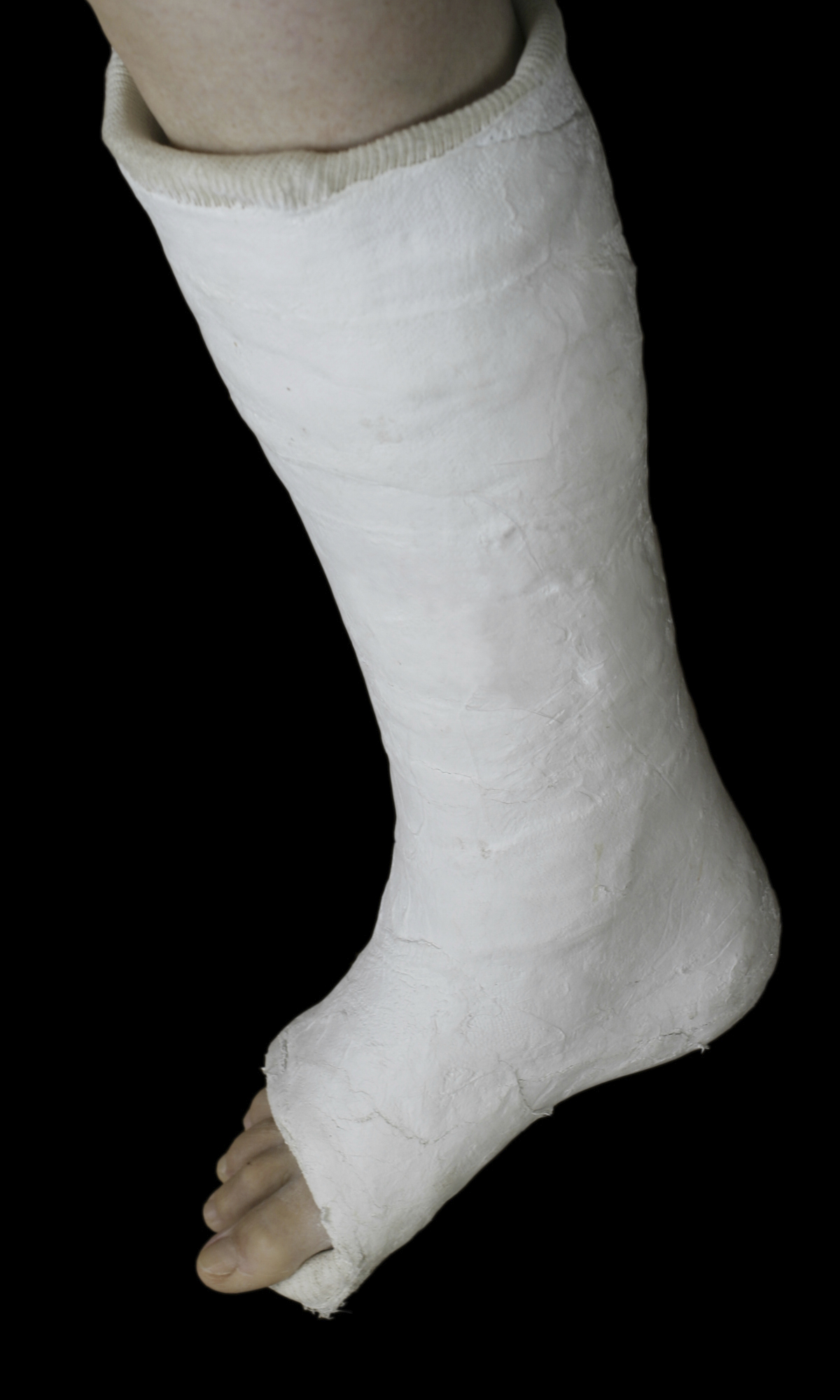 The pain and discomfort may be overwhelming if you experience a broken ankle. Research has shown that treatment needs to be started as quickly as possible and this may extend for a period of six to twelve weeks. There are specific symptoms that are associated with a broken ankle, including swelling and bruising, the inability to stand or walk on your foot, and the ankle appearing deformed if the bone is dislocated. An effective diagnosis is typically achieved by having an X-ray performed to determine the severity of the fracture. If the break is not severe, the patient may be fitted with a protective boot or a plaster cast in addition to using crutches, which are designed to keep the weight off the ankle. For more severe fractures, the bone may have to be realigned through manual manipulation or surgery, which may require wires and screws to be inserted into your foot. Please consult with a podiatrist if you feel you have broken your ankle to determine the proper treatment options.
The pain and discomfort may be overwhelming if you experience a broken ankle. Research has shown that treatment needs to be started as quickly as possible and this may extend for a period of six to twelve weeks. There are specific symptoms that are associated with a broken ankle, including swelling and bruising, the inability to stand or walk on your foot, and the ankle appearing deformed if the bone is dislocated. An effective diagnosis is typically achieved by having an X-ray performed to determine the severity of the fracture. If the break is not severe, the patient may be fitted with a protective boot or a plaster cast in addition to using crutches, which are designed to keep the weight off the ankle. For more severe fractures, the bone may have to be realigned through manual manipulation or surgery, which may require wires and screws to be inserted into your foot. Please consult with a podiatrist if you feel you have broken your ankle to determine the proper treatment options.
Broken ankles need immediate treatment. If you are seeking treatment, contact one of our podiatrists from New England Foot and Ankle. Our doctors can provide the care you need to keep you pain-free and on your feet.
Broken Ankles
A broken ankle is experienced when a person fractures their tibia or fibula in the lower leg and ankle area. Both of these bones are attached at the bottom of the leg and combine to form what we know to be our ankle.
When a physician is referring to a break of the ankle, he or she is usually referring to a break in the area where the tibia and fibula are joined to create our ankle joint. Ankles are more prone to fractures because the ankle is an area that suffers a lot of pressure and stress. There are some obvious signs when a person experiences a fractured ankle, and the following symptoms may be present.
Symptoms of a Fractured Ankle
- Excessive pain when the area is touched or when any pressure is placed on the ankle
- Swelling around the area
- Bruising of the area
- Area appears to be deformed
If you suspect an ankle fracture, it is recommended to seek treatment as soon as possible. The sooner you have your podiatrist diagnose the fracture, the quicker you’ll be on the way towards recovery.
If you have any questions, please feel free to contact one of our offices located in Chelmsford and Newburyport, MA . We offer the newest diagnostic and treatment technologies for all your foot care needs.
Plantar Warts Cause Pain in the Heel
 The medical name for a condition that is commonly known as plantar warts is called verrucae warts. It is a result of the human papillomavirus (HPV) that typically enters the foot through small cracks in the heel and will affect the skin on the bottom of the feet. If you are afflicted with this painful foot condition, you may experience symptoms that include pain while walking as a result of pressure the heel must endure, and a yellow and hardened area on the skin, possibly with small black spots in the center. This virus lives in areas that are consistently moist and humid, which may include swimming pools and the surrounding areas or locker rooms. There are several different treatment options that can be implemented, which may provide the desired relief, and it is suggested to speak with a podiatrist to discuss which is the best one for you.
The medical name for a condition that is commonly known as plantar warts is called verrucae warts. It is a result of the human papillomavirus (HPV) that typically enters the foot through small cracks in the heel and will affect the skin on the bottom of the feet. If you are afflicted with this painful foot condition, you may experience symptoms that include pain while walking as a result of pressure the heel must endure, and a yellow and hardened area on the skin, possibly with small black spots in the center. This virus lives in areas that are consistently moist and humid, which may include swimming pools and the surrounding areas or locker rooms. There are several different treatment options that can be implemented, which may provide the desired relief, and it is suggested to speak with a podiatrist to discuss which is the best one for you.
Plantar warts can be very uncomfortable. If you need your feet checked, contact one of our podiatrists from New England Foot and Ankle. Our doctors will assist you with all of your foot and ankle needs.
About Plantar Warts
Plantar warts are the result of HPV, or human papillomavirus, getting into open wounds on the feet. They are mostly found on the heels or balls of the feet.
While plantar warts are generally harmless, those experiencing excessive pain or those suffering from diabetes or a compromised immune system require immediate medical care. Plantar warts are easily diagnosed, usually through scraping off a bit of rough skin or by getting a biopsy.
Symptoms
- Lesions on the bottom of your feet, usually rough and grainy
- Hard or thick callused spots
- Wart seeds, which are small clotted blood vessels that look like little black spots
- Pain, discomfort, or tenderness of your feet when walking or standing
Treatment
- Freezing
- Electric tool removal
- Laser Treatment
- Topical Creams (prescription only)
- Over-the-counter medications
To help prevent developing plantar warts, avoid walking barefoot over abrasive surfaces that can cause cuts or wounds for HPV to get into. Avoiding direct contact with other warts, as well as not picking or rubbing existing warts, can help prevent the further spread of plantar warts. However, if you think you have developed plantar warts, speak to your podiatrist. He or she can diagnose the warts on your feet and recommend the appropriate treatment options.
If you have any questions please feel free to contact one of our offices located in Chelmsford and Newburyport, MA . We offer the newest diagnostic and treatment technologies for all your foot and ankle needs.
How Are Foot Ulcers Classified?
 A foot ulcer is commonly known as “diabetic foot” and as its name suggests, it’s a frequent condition among diabetic patients. It is a wound on the foot that heals slowly and generally forms on the ball of the foot or the bottom of the big toe. Serious conditions can develop from an infected wound that is left untreated, including poor circulation, nerve damage, and in extreme cases risk of limb amputation. Diabetic foot ulcers can be classified into 4 groups. A wound that does not show signs of an infection is called uninfected. When the area around the wound has turned red, is warm to the touch, painful, or slightly swollen, this is known as a mild infection. If the infection involves deeper layers of skin down into the muscle, tendons, bone or joints, then a moderate infection is likely. A high body temperature or fever, accompanied with heavy breathing or a fast heartbeat can cause sepsis making this a severe infection. If you are a diabetic patient and notice a wound on your foot, it is strongly suggested that you are under the care of a podiatrist regularly who can offer you proper wound care treatment.
A foot ulcer is commonly known as “diabetic foot” and as its name suggests, it’s a frequent condition among diabetic patients. It is a wound on the foot that heals slowly and generally forms on the ball of the foot or the bottom of the big toe. Serious conditions can develop from an infected wound that is left untreated, including poor circulation, nerve damage, and in extreme cases risk of limb amputation. Diabetic foot ulcers can be classified into 4 groups. A wound that does not show signs of an infection is called uninfected. When the area around the wound has turned red, is warm to the touch, painful, or slightly swollen, this is known as a mild infection. If the infection involves deeper layers of skin down into the muscle, tendons, bone or joints, then a moderate infection is likely. A high body temperature or fever, accompanied with heavy breathing or a fast heartbeat can cause sepsis making this a severe infection. If you are a diabetic patient and notice a wound on your foot, it is strongly suggested that you are under the care of a podiatrist regularly who can offer you proper wound care treatment.
Wound care is an important part in dealing with diabetes. If you have diabetes and a foot wound or would like more information about wound care for diabetics, consult with one of our podiatrists from New England Foot and Ankle. Our doctors will assess your condition and provide you with quality foot and ankle treatment.
What Is Wound Care?
Wound care is the practice of taking proper care of a wound. This can range from the smallest to the largest of wounds. While everyone can benefit from proper wound care, it is much more important for diabetics. Diabetics often suffer from poor blood circulation which causes wounds to heal much slower than they would in a non-diabetic.
What Is the Importance of Wound Care?
While it may not seem apparent with small ulcers on the foot, for diabetics, any size ulcer can become infected. Diabetics often also suffer from neuropathy, or nerve loss. This means they might not even feel when they have an ulcer on their foot. If the wound becomes severely infected, amputation may be necessary. Therefore, it is of the upmost importance to properly care for any and all foot wounds.
How to Care for Wounds
The best way to care for foot wounds is to prevent them. For diabetics, this means daily inspections of the feet for any signs of abnormalities or ulcers. It is also recommended to see a podiatrist several times a year for a foot inspection. If you do have an ulcer, run the wound under water to clear dirt from the wound; then apply antibiotic ointment to the wound and cover with a bandage. Bandages should be changed daily and keeping pressure off the wound is smart. It is advised to see a podiatrist, who can keep an eye on it.
If you have any questions, please feel free to contact one of our offices located in Chelmsford and Newburyport, MA . We offer the newest diagnostic and treatment technologies for all your foot care needs.
Disadvantages of Wearing High Heels
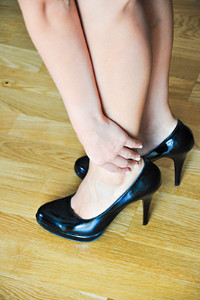 Wearing high heels may possibly be the reason why many women experience foot pain. Despite the fact that most women think high heels flatter the appearance of their legs, several issues may develop as a result of wearing this type of shoe. When high heels are worn, the foot is often in an unnatural position, which may inhibit blood circulation to the feet. The purpose of the Achilles tendon is to connect the calf to the heel. A disadvantage of wearing high heels is that heels may cause this tendon to become stiff and inflamed, possibly resulting in the development of additional foot ailments. Recent research has shown that moderation is the key to wearing high heels, and limiting the number of days they are worn may benefit the overall well-being of the foot. If you experience discomfort and pain from wearing high heels, please consult with a podiatrist to learn about proper stretching techniques for the foot.
Wearing high heels may possibly be the reason why many women experience foot pain. Despite the fact that most women think high heels flatter the appearance of their legs, several issues may develop as a result of wearing this type of shoe. When high heels are worn, the foot is often in an unnatural position, which may inhibit blood circulation to the feet. The purpose of the Achilles tendon is to connect the calf to the heel. A disadvantage of wearing high heels is that heels may cause this tendon to become stiff and inflamed, possibly resulting in the development of additional foot ailments. Recent research has shown that moderation is the key to wearing high heels, and limiting the number of days they are worn may benefit the overall well-being of the foot. If you experience discomfort and pain from wearing high heels, please consult with a podiatrist to learn about proper stretching techniques for the foot.
High heels have a history of causing foot and ankle problems. If you have any concerns about your feet or ankles, contact one of our podiatrists from New England Foot and Ankle. Our doctors can provide the care you need to keep you pain-free and on your feet.
Effects of High Heels on the Feet
High heels are popular shoes among women because of their many styles and societal appeal. Despite this, high heels can still cause many health problems if worn too frequently.
Which Parts of My Body Will Be Affected by High Heels?
- Ankle Joints
- Achilles Tendon – May shorten and stiffen with prolonged wear
- Balls of the Feet
- Knees – Heels cause the knees to bend constantly, creating stress on them
- Back – They decrease the spine’s ability to absorb shock, which may lead to back pain. The vertebrae of the lower back may compress.
What Kinds of Foot Problems Can Develop from Wearing High Heels?
- Corns
- Calluses
- Hammertoe
- Bunions
- Morton’s Neuroma
- Plantar Fasciitis
How Can I Still Wear High Heels and Maintain Foot Health?
If you want to wear high heeled shoes, make sure that you are not wearing them every day, as this will help prevent long term physical problems. Try wearing thicker heels as opposed to stilettos to distribute weight more evenly across the feet. Always make sure you are wearing the proper shoes for the right occasion, such as sneakers for exercising. If you walk to work, try carrying your heels with you and changing into them once you arrive at work. Adding inserts to your heels can help cushion your feet and absorb shock. Full foot inserts or metatarsal pads are available.
If you have any questions please feel free to contact one of our offices located in Chelmsford and Newburyport, MA . We offer the newest diagnostic and treatment technologies for all your foot and ankle needs.
Tips for Avoiding Running Injuries
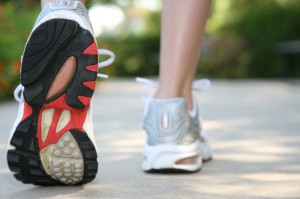 It is very important that you take precautions prior to starting your running routine. Running injuries can happen easily due to running too much too soon, or by wearing the wrong shoes. Poorly fitting running shoes have the potential to cause blisters, corns, and calluses; this is why it is advised to try on your shoes prior to wearing them to make sure they fit properly. When you are looking for a new running shoe it is important that the ball of your foot matches where the shoe bends. Furthermore, you should replace your running shoes on a regular basis. The average life of a running shoe is 350 to 500 miles, but if you are a heavy runner, you may need to replace them even sooner.
It is very important that you take precautions prior to starting your running routine. Running injuries can happen easily due to running too much too soon, or by wearing the wrong shoes. Poorly fitting running shoes have the potential to cause blisters, corns, and calluses; this is why it is advised to try on your shoes prior to wearing them to make sure they fit properly. When you are looking for a new running shoe it is important that the ball of your foot matches where the shoe bends. Furthermore, you should replace your running shoes on a regular basis. The average life of a running shoe is 350 to 500 miles, but if you are a heavy runner, you may need to replace them even sooner.
Exercising your feet regularly with the proper foot wear is a great way to prevent injuries. If you have any concerns about your feet, contact one of our podiatrists of New England Foot and Ankle. Our doctors will treat your foot and ankle needs.
How to Prevent Running Injuries
Many common running injuries are caused by overuse and overtraining. When the back of the kneecap starts wearing out and starts causing pain in your knee, this is commonly referred to as runner’s knee. Runner’s knee is a decrease in strength in your quadriceps and can occur if you’re not wearing properly fitted or supporting shoes. To prevent runner’s knee, focusing on hip strengthening is a good idea, as well as strengthening your quads to keep the kneecaps aligned.
What Are Some Causes of Running Injuries?
- One cause of a common running injury is called iliotibial band syndrome.
- Plantar fasciitis is also another common injury.
- Stress fractures can occur from overtraining, lack of calcium, or even your running style.
Best Ways to Prevent Running Injuries
- Wear footwear that fits properly and suits your running needs.
- Running shoes are the only protective gear that runners have to safeguard them from injury.
- Make a training schedule. Adding strengthening exercises as well as regular stretching can help keep you strong and limber and can lessen the possibility of injuries.
- Stretching keeps muscles limber; this will help you gain better flexibility.
If you have any questions please feel free to contact one of our offices located in Chelmsford and Newburyport, MA . We offer the newest diagnostic and treatment technologies for all your foot and ankle needs.
Foot Concerns for People of a Certain Age
 Foot diseases and other foot-related problems often become more prevalent as we age. Years of bearing body weight and certain ailments can combine to wreak havoc on the feet and ankles. The foot problems we may experience as time goes on vary from minor to potentially very serious. First and foremost, if you are a diabetic, foot care needs to be a high priority. Diabetic ulcers and sores, if left untreated, can lead to infection and even gangrene, resulting in amputation. Daily foot inspections are necessary to ensure that there are no cuts, sores, or swelling. Even something as seemingly minor as cracked skin on the foot can lead to terrible consequences if gone unnoticed. Using moisturizer and soap that doesn’t dry out the skin can help in this area. That being said, it is also important to keep the feet dry, as toenail fungus grows more readily in moist environments. Keeping the feet elevated is also a good tip. This will help circulate the blood to the lower extremities. Poor circulation can lead to serious medical conditions.
Foot diseases and other foot-related problems often become more prevalent as we age. Years of bearing body weight and certain ailments can combine to wreak havoc on the feet and ankles. The foot problems we may experience as time goes on vary from minor to potentially very serious. First and foremost, if you are a diabetic, foot care needs to be a high priority. Diabetic ulcers and sores, if left untreated, can lead to infection and even gangrene, resulting in amputation. Daily foot inspections are necessary to ensure that there are no cuts, sores, or swelling. Even something as seemingly minor as cracked skin on the foot can lead to terrible consequences if gone unnoticed. Using moisturizer and soap that doesn’t dry out the skin can help in this area. That being said, it is also important to keep the feet dry, as toenail fungus grows more readily in moist environments. Keeping the feet elevated is also a good tip. This will help circulate the blood to the lower extremities. Poor circulation can lead to serious medical conditions.
If you need your feet checked, contact one of our podiatrists of New England Foot and Ankle. Our doctors will attend to all of your foot and ankle needs and provide you with quality treatment.
Geriatrics and Podiatry
When people age, some common issues that may occur are bone density loss, dry skin, poor circulation, and rough brittle nails. These issues may also affect your foot health if the necessary steps are not taken to alleviate the problems.
It is important to take care of your feet because feet that are injured or diseased can affect your overall health. Having painful feet hinders your ability to do daily activities or may decrease your willingness to do the things that you need to do.
Visiting Your Geriatrician
As we age, health problems become more likely, so it is essential to visit your doctor for check-ups to ensure that you are doing the best you can to take care of your health. It is recommended to check your feet frequently for any possible cuts, bruises, swelling, corns or any other irregularities.
Taking Care of Elderly Feet
Cracked or dry feet can be treated by applying moisturizer often. It is also important not to wear old socks because the older the sock is, the higher the possibility there will be that there is bacteria there. Wear fresh socks and make sure they fit properly.
Proper foot health means that you can have a more active lifestyle and you will not be bogged down by pain. Foot health also leads to good circulation, which is paramount for overall health.
If you have any questions, please feel free to contact one of our offices located in Chelmsford and Newburyport, MA . We offer the newest diagnostic tools and technology to treat your foot and ankle needs.
Ingrown Toenail Prevention
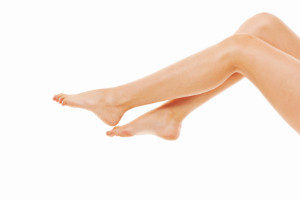 Ingrown toenails occur when the corner or side of the toenail starts to grow into the soft flesh that surrounds it. As a result, one may experience pain, redness, swelling, and infection. People who have diabetes or poor circulation in their feet may be at a greater risk of developing an ingrown toenail. In order to prevent getting an ingrown toenail, you should try to cut your toenail straight across instead of in a rounded shape. Wearing shoes that fit properly may also help avoid the development of ingrown toenails. It is possible that the pain you experience from an ingrown toenail may spread to other parts of your feet, so it is crucial that you seek assistance from a podiatrist.
Ingrown toenails occur when the corner or side of the toenail starts to grow into the soft flesh that surrounds it. As a result, one may experience pain, redness, swelling, and infection. People who have diabetes or poor circulation in their feet may be at a greater risk of developing an ingrown toenail. In order to prevent getting an ingrown toenail, you should try to cut your toenail straight across instead of in a rounded shape. Wearing shoes that fit properly may also help avoid the development of ingrown toenails. It is possible that the pain you experience from an ingrown toenail may spread to other parts of your feet, so it is crucial that you seek assistance from a podiatrist.
Ingrown toenails can become painful if they are not treated properly. For more information about ingrown toenails, contact one of our podiatrists of New England Foot and Ankle. Our doctors can provide the care you need to keep you pain-free and on your feet.
Ingrown Toenails
Ingrown toenails occur when a toenail grows sideways into the bed of the nail, causing pain, swelling, and possibly infection.
Causes
- Bacterial infections
- Improper nail cutting such as cutting it too short or not straight across
- Trauma to the toe, such as stubbing, which causes the nail to grow back irregularly
- Ill-fitting shoes that bunch the toes too close together
- Genetic predisposition
Prevention
Because ingrown toenails are not something found outside of shoe-wearing cultures, going barefoot as often as possible will decrease the likeliness of developing ingrown toenails. Wearing proper fitting shoes and using proper cutting techniques will also help decrease your risk of developing ingrown toenails.
Treatment
Ingrown toenails are a very treatable foot condition. In minor cases, soaking the affected area in salt or antibacterial soaps will not only help with the ingrown nail itself, but also help prevent any infections from occurring. In more severe cases, surgery is an option. In either case, speaking to your podiatrist about this condition will help you get a better understanding of specific treatment options that are right for you.
If you have any questions please feel free to contact one of our offices located in Chelmsford and Newburyport, MA . We offer the newest diagnostic and treatment technologies for all your foot and ankle needs.
Buying the Right Shoes for the Right Sport
 Proper support is crucial while running and is typically obtained through purchasing running shoes as opposed to shoes designed for walking. Running is considered a high impact sport, and it’s important to have the correct cushioned shoes to help promote proper balance. A firmer sole is important to a runner for maintaining stability, and a sole that’s more flexible is easier for a walker to wear as it grips the toe and the heel. Thick heels are preferred in running shoes as they provide proper cushioning and support for the jogger. If a walker should wear shoes made for running, they may experience conditions such as shin splints or Achilles tendons injuries. This is often because the mechanics of walking and running are different. Running shoes offer features designed to keep the foot in a neutral position and may provide more stability than walking shoes. An additional difference between the two types of shoes may be that running shoes are made of lighter materials that are meant to enable a jogger to move faster.
Proper support is crucial while running and is typically obtained through purchasing running shoes as opposed to shoes designed for walking. Running is considered a high impact sport, and it’s important to have the correct cushioned shoes to help promote proper balance. A firmer sole is important to a runner for maintaining stability, and a sole that’s more flexible is easier for a walker to wear as it grips the toe and the heel. Thick heels are preferred in running shoes as they provide proper cushioning and support for the jogger. If a walker should wear shoes made for running, they may experience conditions such as shin splints or Achilles tendons injuries. This is often because the mechanics of walking and running are different. Running shoes offer features designed to keep the foot in a neutral position and may provide more stability than walking shoes. An additional difference between the two types of shoes may be that running shoes are made of lighter materials that are meant to enable a jogger to move faster.
For more information about walking shoes versus running shoes, consult with one of our podiatrists from New England Foot and Ankle. Our doctors can measure your feet to determine what your needs are and help you find an appropriate pair of footwear.
Foot Health: The Differences between Walking & Running Shoes
There are great ways to stay in shape: running and walking are two great exercises to a healthy lifestyle. It is important to know that running shoes and walking shoes are not interchangeable. There is a key difference on how the feet hit the ground when someone is running or walking. This is why one should be aware that a shoe is designed differently for each activity.
You may be asking yourself what the real differences are between walking and running shoes and the answers may shock you.
Differences
Walking doesn’t involve as much stress or impact on the feet as running does. However, this doesn’t mean that you should be any less prepared. When you’re walking, you land on your heels and have your foot roll forward. This rolling motion requires additional support to the feet.
Flexibility – Walking shoes are designed to have soft, flexible soles. This allows the walker to push off easily with each step.
If you have any questions, please feel free to contact one of our offices located in Chelmsford and Newburyport, MA . We offer the newest diagnostic and treatment technologies for all your foot care needs.
Featured Articles
- April 2025
- March 2025
- February 2025
- January 2025
- December 2024
- November 2024
- October 2024
- September 2024
- August 2024
- July 2024
- June 2024
- May 2024
- April 2024
- March 2024
- February 2024
- January 2024
- December 2023
- November 2023
- October 2023
- September 2023
- August 2023
- July 2023
- June 2023
- May 2023
- April 2023
- March 2023
- February 2023
- January 2023
- December 2022
- November 2022
- October 2022
- September 2022
- August 2022
- July 2022
- June 2022
- May 2022
- April 2022
- March 2022
- February 2022
- January 2022
- December 2021
- November 2021
- October 2021
- September 2021
- August 2021
- July 2021
- June 2021
- May 2021
- April 2021
- March 2021
- February 2021
- January 2021
- December 2020
- November 2020
- October 2020
- September 2020
- August 2020
- July 2020
- June 2020
- May 2020
- April 2020
- March 2020
- February 2020
- January 2020
- December 2019
- November 2019
- October 2019
- September 2019
- August 2019
- July 2019
- June 2019
- May 2019
- April 2019
- March 2019
- February 2019
- January 2019
- December 2018
- November 2018
- October 2018
- September 2018
- August 2018
- July 2018
- June 2018
- May 2018
- April 2018
- March 2018
- February 2018
- January 2018
- December 2017
- November 2017
- October 2017
- September 2017
- August 2017
- July 2017
- June 2017
- May 2017
- April 2017
- March 2017
- February 2017
- March 2016
